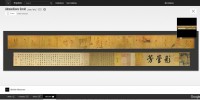 The Google Cultural Institute (GCI) and the British Museum have worked together to make it possible people all over the world to enjoy the museum’s many offerings from the comfort of their homes. So far 4,654 objects and artworks have been made available for our perusal. Google’s Street View cameras have trundled through the museum’s vast halls, so you can virtually walk through them from the second basement to the fifth floor, the largest indoor space yet captured on Street View. They’ve even captured the outdoors so you have a stroll around the beautiful museum building itself.
The Google Cultural Institute (GCI) and the British Museum have worked together to make it possible people all over the world to enjoy the museum’s many offerings from the comfort of their homes. So far 4,654 objects and artworks have been made available for our perusal. Google’s Street View cameras have trundled through the museum’s vast halls, so you can virtually walk through them from the second basement to the fifth floor, the largest indoor space yet captured on Street View. They’ve even captured the outdoors so you have a stroll around the beautiful museum building itself.
The British Museum has an excellent website with more than 3.5 million objects in its searchable database, 920,000 of them with one of more photographs attached. Many of the pictures are very good, but even the largest of them are modestly sized (the usual caveat regarding my obsession with high resolution photography applies, of course) and there are a significant number that look dated or are in black and white. It’s a wonderful thing, therefore, to have fresh images of thousands of objects in ultra high resolution courtesy of Google’s gigapixel cameras.
For example, the museum’s entry for the Admonitions Scroll, a Chinese painted silk handscroll more than 11 feet long from the 5th to the 8th century that depicts scenes from a 3rd century court poem, has 247 images. If you want to explore the details, you can go through the pictures one by one, but it’s tedious to have to go back and forth and the photo quality is less than satisfying. There are duplicates, old black and white shots and none of the pics I clicked on are more than 750 pixels wide. The scroll looks dingy, the painting dim.
 Contrast that with the version on the Google Cultural Institute’s British Museum page. It’s a whole different viewing experience, like someone turned the light on in the room. You can see the whole thing in front of you at once. You can view the work in a depth of detail that you couldn’t possibly achieve in person unless your name is Steve Austin and they’ve made your other eye bionic too. You can see the weave of the silk, the individual hairs in the brushstrokes. It’s stupefying.
Contrast that with the version on the Google Cultural Institute’s British Museum page. It’s a whole different viewing experience, like someone turned the light on in the room. You can see the whole thing in front of you at once. You can view the work in a depth of detail that you couldn’t possibly achieve in person unless your name is Steve Austin and they’ve made your other eye bionic too. You can see the weave of the silk, the individual hairs in the brushstrokes. It’s stupefying.
In addition to the objects from the permanent collection, there are also online versions of the museum’s temporary exhibitions, six of them right now with more to come. I’ve been pining to see Celtic Life in Iron Age Britain since it opened at the end of September. Gorgeous examples of Celtic metalwork, jewelry, objects of daily use and more are now viewable in detail online. It’s a curated online exhibit, not just a list of objects, arranged in a logical progression accompanied by explanatory notes. No Gundestrup Cauldron, though, sadly. It’s on the National Museum of Denmark’s GCI page, but not in gigapixel fun.
 The collaboration between Google and the British Museum has also paved new territory for digital museum offerings. The Museum of the World microsite allows viewers to explore a timeline of artifacts divided into their continents of origin but then linked together by thematic connections. You swoop through time to a sparkly wind chimes sound effect while the objects load as polka dots, different colors for each part of the world — Africa, the Americas, Asia, Europe and Oceania. When you click on one of the dots, you see a small thumbnail and the title of the object and lines radiate outwards connecting it to other objects. If you want to learn more, click again. The detail view has a text explanation of the piece, an audio description introduced by a narrator and expanded on by a relevant curator. Click on the picture to see it in high resolution. On the right side under the audio there’s a map so you can see where the piece came from and then a few thumbnails of related works if you’d like to skip directly their detail views.
The collaboration between Google and the British Museum has also paved new territory for digital museum offerings. The Museum of the World microsite allows viewers to explore a timeline of artifacts divided into their continents of origin but then linked together by thematic connections. You swoop through time to a sparkly wind chimes sound effect while the objects load as polka dots, different colors for each part of the world — Africa, the Americas, Asia, Europe and Oceania. When you click on one of the dots, you see a small thumbnail and the title of the object and lines radiate outwards connecting it to other objects. If you want to learn more, click again. The detail view has a text explanation of the piece, an audio description introduced by a narrator and expanded on by a relevant curator. Click on the picture to see it in high resolution. On the right side under the audio there’s a map so you can see where the piece came from and then a few thumbnails of related works if you’d like to skip directly their detail views.
 I found it thoroughly engrossing. I scrolled all the way to the back of the timeline to the oldest artifact in the museum: a 1.8 million-year-old basalt chopping tool from the Olduvai Gorge in Tanzania. It has only one connected piece — an 800,000-year-old Olduvai handaxe — by the related objects thumbnails take you far afield to an archaic Native American birdstone (1,000-1,500 B.C.) and an early 19th century Inuit ulu (a crescent-shaped knife). Once you get to the handaxe, the radiating lines proliferate.
I found it thoroughly engrossing. I scrolled all the way to the back of the timeline to the oldest artifact in the museum: a 1.8 million-year-old basalt chopping tool from the Olduvai Gorge in Tanzania. It has only one connected piece — an 800,000-year-old Olduvai handaxe — by the related objects thumbnails take you far afield to an archaic Native American birdstone (1,000-1,500 B.C.) and an early 19th century Inuit ulu (a crescent-shaped knife). Once you get to the handaxe, the radiating lines proliferate.
You can browse by continent — just click the name and all the other dots will disappear, click it again for them to return — or by the themes listed in the menu to the right. Click the three squares in the upper left corner to cut the scrolling and jump to specific times.
Seriously this feature is the rabbit hole of all rabbit holes. I would strongly recommend you only click on the first link when you have a nice chunk of time available, because there is no way in hell you’ll be able to stop once you get started. This is ideal lost weekend material.
“the rabbit hole of all rabbit holes”: beware ferrets and nets.
Lovely!